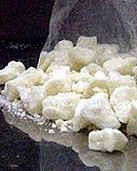


Cocaine occurs naturally in the leaves of the South American coca plant, although itís usually treated before it hits the streets. It comes as a white powder - cocaine hydrochloride - though people still chew the original coca leaves sometimes. Most Coke users sniff it up their noses using a rolled up piece of paper, or banknote to show off. Scientists think it works by overdosing your nerves on a natural brain messenger that tells them to feel pleasure, called dopamine. However, cocaine stops you making dopamine after you sniff it for a while, so you canít feel happy again until you get more cocaine. Then you get addicted just to feel normal.
Crack is a derivative of cocaine which comes in small white crystals. When heated they make a 'crack' or 'popping' sound. Crack smoke rushes to your brain and you get a mere 2 minutes intensive rush, followed by a 20 minutes buzz and then a totally massive crash. It is very, very addictive'.
Itís very illegal - a serious Class A drug, which means that you can get up to 7 years in prison and huge fines for possessing it, and Life imprisonment for supplying it.
The West discovered cocaine in the 1870s and thought it was fantastic. Lots of energy drinks had sprinkles of it, including Coca-Cola. It wasnít until 1900 or so that doctors realised how dangerous it is. Coke stopped using it in 1902 but kept the name.
99% of banknotes in London have tiny traces of cocaine on them.